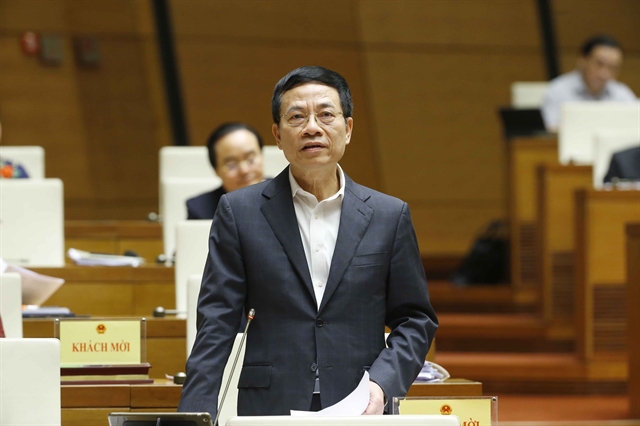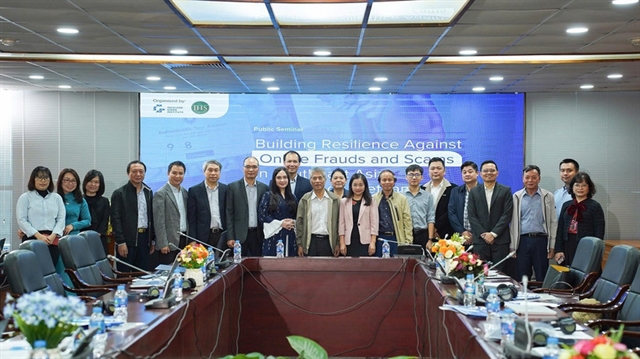 Politics & Law
Politics & Law


|
| Minister of Information and Communications Nguyễn Mạnh Hùng is answering questions at the Q&A session on Monday. VNA/VNS Photo |
HÀ NỘI — Minister of Information and Communications Nguyễn Mạnh Hùng said the Government is considering a proposal for a code of conduct for cyberspace in Việt Nam and will issue the code by the end of this year.
He was answering questions from a National Assembly deputy regarding child protection in cyberspace at a Q&A session yesterday.
The code would require internet users and service providers to comply with Vietnamese laws and respect the rights and interests of organisations and individuals, including the rights of children. Specifically, it would require social media users and internet service providers to guide children and adolescents on safe and healthy use of social networks.
In addition, the Ministry of Information and Communications was assigned by Prime Minister Nguyen Xuan Phuc to take the lead in developing a project to protect and support children to interact creatively and healthy online for 2010 - 2025. The project has provided basic solutions to solve problems such as creating a single focal point in cyberspace to receive feedback on child abuse content, applying technology, artificial intelligence, and analysing big data to detect and remove child abuse content.
Digital transformation for mountainous areas
Regarding digital transformation for people in mountainous areas, Hùng said in the digital transformation project, digital regulation for mountainous and remote areas is considered a priority.
Regarding telecommunications infrastructure, the ministry has directed that all people in mountainous, remote and isolated areas must have 3G, 4G, and 5G to be able to access the internet.
In terms of electronic payment infrastructure, this year, the Government and the State Bank of Việt Nam will trial the mobile money model so that people in remote areas without a bank card can make electronic payments. For people in remote and difficult areas with no smartphones, at present, a co-operation programme between Vietnamese manufacturers and carriers is available to support selling at a reasonable price, Hùng said.
Regarding digital transformation for people in mountainous areas, the first priority is education, especially online education so children there can access the best education. The second priority is healthcare, Hùng said, adding that remote medical examination and treatment systems will be deployed for people in these areas soon.
Labour and vocational education
Earlier in the morning, the NA continued its question and answer programme about labour and vocational education.
Deputy Đỗ Thị Lan from Quảng Ninh Province asked about planning the network of vocational institutions to meet the requirements of socio-economic development. Minister of Labour, Invalids and Social Affairs Đào Ngọc Dung said the ministry would rearrange the system of vocational education centres and close ineffective ones.
Dung said after three years, the Ministry of Labour, Invalids and Social Affairs (MoLISA) has completed all legal documents. Provinces and different ministries and sectors have reorganised and reduced from 1996 to 1909 vocational education schools, completing the target before 2021. Việt Nam's vocational education schools now rank 90th out of 158 countries and territories in the world for quality, up 10 places compared to last year, per the World Economic Forum.
Emphasising the encouragement of establishing private foreign-invested educational institutions associated with human resources use for business sectors under the revised Labour Code 2019, Dung said with the direction of rearranging vocational education centres, each province would have only one or two multi-disciplinary and multi-system training colleges.
The MoLISA will encourage investment in a high-quality education system, key occupations and publish the national qualification framework according to the ASEAN qualification framework.
This plan also promotes international co-operation and recognises diplomas and certificates of ASEAN countries and some highly developed vocational training countries, focusing on three countries, namely Australia, Japan and Germany.
The goal is that by 2030, there will be 100 high-quality schools, 50 schools meeting ASEAN standards and Việt Nam’s vocational education will reach an advanced level in ASEAN.
"We apply a number of new training plans and methods to suit the digital transformation society through online training for students, promote creativity for young people and employees to study and work remotely,” said Dung. — VNS




